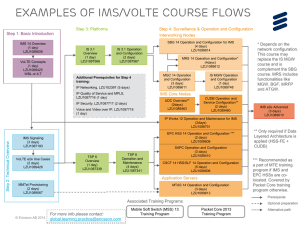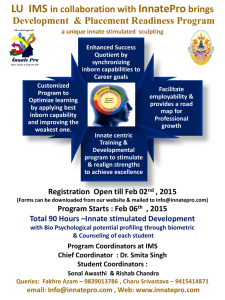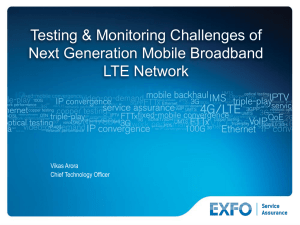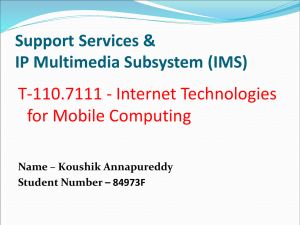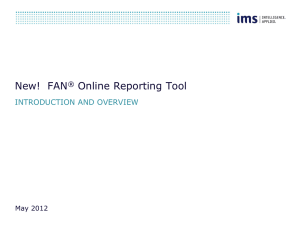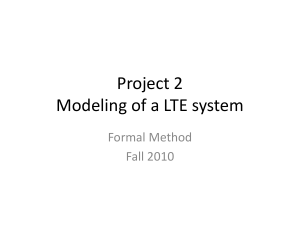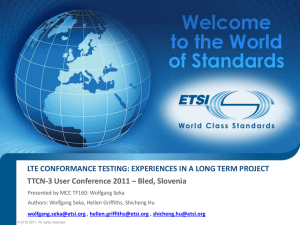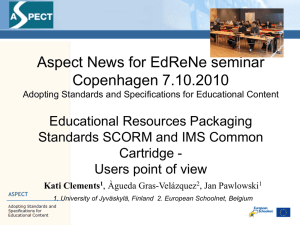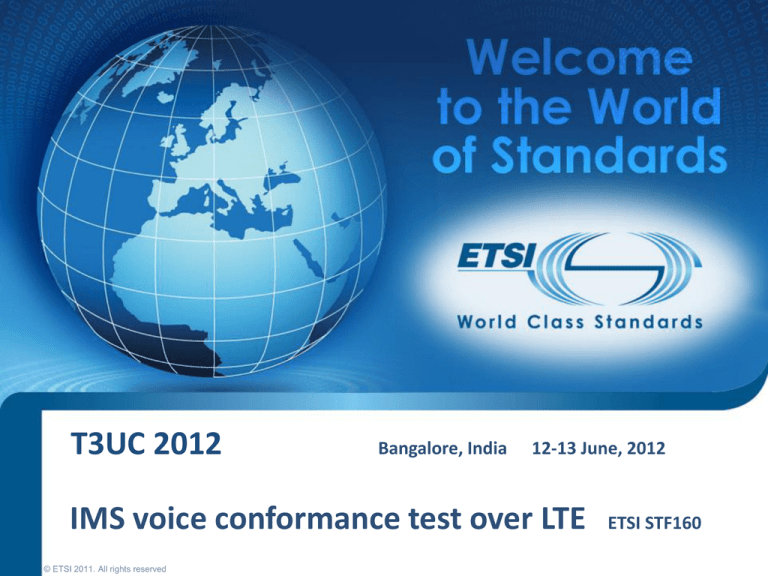
T3UC 2012
Bangalore, India
12-13 June, 2012
IMS voice conformance test over LTE
© ETSI 2011. All rights reserved
ETSI STF160
IMS voice conformance test over LTE
The Project
Support of Voice in LTE
• Voice options in LTE
• SRVCC Architecture
• SRVCC call Message flow
• Test Model Enhancements for IMS
The Experience
Conclusions
2
© ETSI 2011. All rights reserved
THE PROJECT
3
© ETSI 2011. All rights reserved
3GPP UE conformance test (1/2)
Mobile terminal conformance is one of the key issues in the mobile
industry, impacting interoperability.
3GPP RAN5 and GERAN3 are responsible for UE conformance test
specifications
A task force STF160 under TSG RAN/RAN5 develops, maintains,
delivers the 3GPP UE test suites in TTCN
Only these TTCN test cases produced at ETSI are valid for the UE
certifications
Applied by certification bodies like GCF, PTCRB
ETSI CTI provides to 3GPP the STF leadership and management of all
3GPP TTCN-related matters
The STF has 18 experts from ETSI, CCSA and ATIS
•
The largest testing project supported by ETSI
Funding 90 mm / year
•
3GPP funding 58 mm (754k Euro)
• Voluntary contributions 32 mm as man power, free-of-charge from
TDIA and other 3GPP companies
4
3GPP UE conformance test (2/2)
UE conformance test covers seven technologies: LTE, W-CDMA, TDSCDMA, GSM/GPRS, IMS, CDMA2000 and inter-technology mobility
and roaming
•
•
•
For all mobile devices and modules
For all 3GPP/3GPP2 frequency Bands
For 7 3GPP Releases (Rel-9 - backwards to R99)
The team maintains 2200 test cases,
Develops 200 new test cases / year
Provides 12 deliveries / year
Baseline upgrade once per year
MCC TF160: Signalling Conformance Tests for 3GPP (RAN5: Testing)
• Task: Develop Conformance Test Suites for UE world-wide certification
• 2000..now
Conformance Tests for UMTS Signalling FDD/TDD
•
•
•
•
5
2006..now
2007..2008
2008..now
2011..now
© ETSI 2011. All rights reserved
(TTCN-2++) (Rel-99 ... Rel9)
Conformance Tests for IMS (TTCN-3, bearer agnostic)
Pre-evaluation of TTCN-3 for LTE Signalling
3GPP LTE/SAE UE Conformance Test[Rel8 & Rel9]
IMS Emergency Call/ SRVCC calls in LTE/SAE->
UTRAN/GERAN/CDMA 1XRTT
LTE/SAE Project
Test cases:
393 Verified
+ 75 LTE/SAE + 39 Positioning fully implemented
613 test cases planned [Rel 8 & Rel 9]
120+ planned for IMS
Code size:
• 263 Modules
• App. 240 K Lines of code (TTCN-3)
Type Definitions
• TTCN-3:
• ASN.1:
• XML:
> 31 modules, App. 30K lines of code
> 8 modules , App. 50K lines of code
< Not yet used
Tools:
•
•
•
•
6 different compilers (all available at ETSI)
Quality checks (naming conventions, template restrictions etc.)
Code generation (top-level test case definitions, parameters, etc.)
Code analysis (structure, approved objects)
TTCN-3 code is freely available for 3GPP members and widely used
6
http://www.3gpp.org/ftp/tsg_ran/WG5_Test_ex-T1/TTCN/Deliveries/LTE_SAE/
Component Structure (1/3)
MTC
• Start of PTCs, monitoring of “done” and “killed”
• RAT independent interfaces (e.g. AT-/MMI-commands to
control the UE)
• In general no pass/fail verdicts
PTCs for each RAT (radio access technology)
•
•
•
•
LTE, UMTS, GSM/GPRS, CDMA2000
May be connected to any other RAT PTC
Only RAT specific interfaces
Assignment of pass/fail verdicts
Ports and interfaces
• Connections: only one-to-one
( no “send to”, “receive from”; no use of address data
type)
• No duplicated interfaces: e.g. only one interface for AT/MMI-commands hosted by the MTC
• Message based communication only
7
© ETSI 2011. All rights reserved
Component Structure (2/3)
PTCs for other protocols
IP PTC
•
•
•
•
•
IP data (e.g. DHCP, ICMPv6) handling
To keep system interface simple and deal with “parallel behaviour”
In general no test characteristic ( no pass/fail verdicts)
Possibility to provide non standard test specific behaviour by routing the IP
messages to EUTRA PTC. Test characterisitic ( pass/fail verdict allocations)
More than one instances possible. One instance per PDN
IMS PTC
•
•
•
•
•
By default provides generic IMS SIP Registration and deregistration
Provides UDP/TCP transport of IMS SIP signalling messages
In general no test characteristic ( no pass/fail verdicts)
Possibility to provide non default, test specific behaviour
More than one instances possible: one instance per PDN
• NAS Emulator
• “protocol layer” underneath LTE PTC
• Performs NAS security (Ciphering/Integrity) with the help of external functions
8
© ETSI 2011. All rights reserved
9 9
SYSIND SYS
NASCTRL
SRB
DRB IP_CTRL IP_Data
IMS_PTC
UTRAN PTC
CDMA2K PTC
M
T
C
SIP_Clnt/Srv
CTRL
Ut
IP_CTRL
NAS Emulator
IP_Data
SIP_Clnt/Srv
Coordination
E_SRB
Upper Tester
(AT , MMI)
Configuration
IP_SOCK
E_SYS
UTRAN PTC
IP_PTC
SYS_SRB
E_SYSIND
GERAN PTC
TC_SRB
Pre-Reg
CDMA2K PTC
G_Ut C2K_Ut
UT
(LTE)
GERAN PTC
U_Ut
EUTRA PTC
CDMA2K PTC
E_Ut
UTRAN GERAN
C2K
Component Structure (3/3)
E_DRB
IP_SOCK
Ut
Signalling
User Data
MUX
System Interface
© ETSI 2011. All rights reserved
Non 3GPP/IMS Protocol
9
SUPPORT OF VOICE IN LTE
10
© ETSI 2011. All rights reserved
Voice options in LTE
LTE is an all packet technology supporting Packet switched domain only
Support for Voice is still a necessity
• Regulatory requirements present for support of voice call [emergency calls]
• In the age of smart phones, voice still accounts for 15% of mobile traffic.
CSFB is 3GPP endorsed initial voice support, commercially launched in 2011.
• LTE networks are deployed alongside legacy voice networks [UTRAN/GERAN/CDMA
•
1xRTT]
UE will be handed over or redirected to the legacy voice RAT when Voice service is
needed
Increases call establishment time by 5 to 8 seconds.
•
SRVCC is next logical step after CSFB in LTE road map
• UE while camping in LTE uses IMS [VoLTE] for voice
• Core network on both sides will be connected and synchronised.
• Allows single Radio in UE to be handed over from VoLTE to legacy CS domain
UTRAN/GERAN/1XRTT; Handover in opposite direction is still not standardised.
Provides a seamless voice experience to customers using LTE multi mode handsets
•
Some operators going for non 3GPP endorsed technologies, for example SVLTE
• UE will be simultaneously camping on LTE network for data and some voice technology
•
•
11
[e.g. 1xRTT] for voice.
No need for core networks to be connected and synchronised
2 UE’s put in one plastic case
© ETSI 2011. All rights reserved
SRVCC call Message flow (1/2)
MTC
EUTRA_PTC
RAT_PTC
NAS_EMU
IMS_PTC
IP_PTC
Power/Switch On
Registration
IP Address Alloc
IMS Registration
PRE Registration / If CDMA
Voice Call Init/Accept
LTE/EPS Call Signaling
IMS SIP Signaling/Voice Call
Measurements on RATcell
Handover
UE completes Handover
IMS SIP Signallig/Media Removal
12
© ETSI 2011. All rights reserved
UE
SRVCC call Complexity
Requires MTC and at-least 5 PTCS [EUTRA,
NAS Emu, IP, IMS and one of target RAT PTC’s]
• Co-ordination between 6 components. [Does not
•
•
•
13
considers multiple instances of IP and IMS
components for multi PDN network simulations]
Signalling handled by these components will be
partially independent with start and stop points,
synchronised with signalling in other components.
Simple and robust inter component co-ordination
message protocol desired. Hand shake signals are
mostly sufficient; configurable RAT specific
information also needs to be shared occasionally.
Requires test case specific behaviour for IMS_PTC,
Verdict assignment in IMS_PTC.
© ETSI 2011. All rights reserved
Future IMS extensions
Tests for Video calls over LTE
requires additional bearer for video.
requires additional IMS profiles.
Tests for IMS Voice call over HSPA (PS domain) and its
handover to CS domain in UTRAN or GERAN
Similar complexity as SRVCC LTE
IMS over HSPA[UTRAN bearer] required
Tests for support of IMS VoLTE call handover to VoHSPA and
vice versa.
More IMS SIP signalling over HSPA after handover for call
release/de-registration
IMS bearers for voice to be supported both in LTE and HSPA
IMS Emergency call over LTE and HSPA
Needs multiple PDN connections, hence multiple instances of IMS
PTC.
Test model needs to be ready for these test requirements
14
© ETSI 2011. All rights reserved
Test Model Enhancements for IMS [1/2]
IMS_PTC
EUTRA_PTC
SIP client
(sec)
SIP server
(sec)
IMS IP CTRL
SIP client
(sec)
SIP server
(sec)
IMS IP CTRL
IP_PTC
L
R
T
C
_
P
I
CTRL
L
R
T
C
Control
IP-Data
Routing
Control
Socket
Control
MUX/Filter
Socket Ctrl
IP_SOCK
IPsec_CTRL
IP_CTRL
IPsec_CTRL
IP_CTRL
IP Data,
Socket Ctrl
System Interface
IP_SOCK
IP-Data
Socket
Ctrl
IP stack
raw mode
DRB-MUX
EUTRA:
UTRAN:
Cellx, DRBy Cellx, RBy
Security
Ctrl
IPsec: SAD, SPD
Routing
Ctrl
IP mode
Routing Table
GERAN
System Adaptor
Functionality in dark green added new; Other functionality also enhanced
SigComp is not required for VoLTE, but may be used for IMS over UTRAN
It may be required in future to add SigComp
15
© ETSI 2011. All rights reserved
Test Model Enhancements for IMS [2/2]
Test case specific IMS PTC
• Provides test case specific IMS behavior.
• Handles default IMS registration &
• Customized SIP signaling for IMS voice call.
• Assigns verdicts
• SIP codec achieved by TTCN 3 built in functions encvalue/decvalue
• Sigcomp not handled yet.
Enhancements to IP PTC
• Added functionality for DHCP/DNS and other IETF protocols during IMS
•
•
•
registration
Enhance IP control for configuring Ipsec in SS IP stack emulation
Routing/receiving of SIP PDU’s to/from IMS PTC by Mux/Filter
Enhanced routing.
Enhancements in SS adaptor
• Ipsec handling, configuration of security policy database (SPD) and
security association database (SAD) security parameters
Possibility to map IMS bearers on UTRAN bearers (VoHSPA)
•
Additional inter component co-ordination ports and messages
16
© ETSI 2011. All rights reserved
THE EXPERIENCE
17
© ETSI 2011. All rights reserved
MCC160 Experience [1/2]
ETSI MCC TF160 is one among few teams simultaneously using TTCN2 and
TTCN3 for ATS development.
• The only ETSI team still using TTCN2 for historical reasons
Language evolution & Tool support
• TTCN2++ frozen in May 1999, with negligible tool enhancements, seems to have
•
exceeded its ‘use by’ period.
TTCN 3 enjoys enviable language/tool enhancements and maintenance
Grey areas in spec
• Grey areas (too late to clarify the standards) with different understanding across tool
vendors, preventing such features usage.
IS_PRESENT, behavior with omitted contents , pointing to a list of elements etc.
• No such issues with TTCN 3 due to active language and tool support;
MCC 160 actively provides such feed back, resulting in clarification in standards and
enhancements of tools.
Fixed Mobile convergence:
• Industry is buzz with fixed mobile convergence, requiring many IP based IETF
protocols [DHCP/DNS/ICMP/SigComp/IPSec…] support in wireless networks
TTCN 2 IP based code getting unreadable with too many octet strings and local trees.
Similar code is very simple in TTCN 3.
Absence of built-in functions like encvalue/decvalue in TTCN 2, proving costly; requires many
TSO’s to be defined
18
© ETSI 2011. All rights reserved
MCC160 Experience [2/2]
Increased code Sizes
• Tests from 7 releases [Rel99, Rel4, Rel5,…Rel9], proving too much for decade old
•
TTCN 2 compilers to handle.
Import tables overhead becoming more than the actual code size.
Higher the release, severe the problem due to modular structure for development.
Resulting in huge, un manageable modules
Compilation and code generation is very time consuming
TTCN 3 tools seem to enjoy immunity against such code expansion
Integration of IMS with LTE was smooth.
Import of a module in TTCN3 is one line with ‘import all’ option.
60k[2009] -> 240k [2012] TTCN 3 lines of code.
90[2009]-> 263[2012] modules
3 [2009]->6+[2012] active components in a test case
No known compiler complains
Proposal to move UTRAN Rel10 and later test development from TTCN 2 to
TTCN 3; possibly to also port existing TTCN2 Rel7 and later tests to TTCN 3.
• Discussion & decision to be made in RAN5 #55 meeting in May 2012
19
© ETSI 2011. All rights reserved
CONCLUSIONS
20
© ETSI 2011. All rights reserved
Conclusions [1/2]
Regulatory requirements for support of voice & commercial need for
interoperability with legacy CS voice service, contributed in most
challenging enhancements in test model and coding MCC TF160
worked on till date.
Integration of IMS in LTE, brought along with its challenges of
handling many flavors of IMS implementations.
TTCN 3 Rocks
• Once again TTCN 3 proved to be a good choice by providing competent
language frame work, to overcome all challenges in integrating IMS with
LTE.
• Even though there is still no formal verification of IMS in LTE, we do have informal claims of
good progress being made; Initial IMS registration performed successfully.
• Successfully demonstrated co-habitation of seven technologies:
•
•
21
LTE[FDD/TDD], W-CDMA, TD-SCDMA, GSM/GPRS, IMS, CDMA HRPD/1XRTT
Active TTCN3 language and tool support is enviable.
Quality check tools, marking approved objects from rest are ‘icing on the
cake’
© ETSI 2011. All rights reserved
Conclusions [2/2]
The successful integration of IMS with LTE, further motivates to
harmonize the IMS code and test model existing in 2 MCC 160
projects:
•
•
•
•
•
•
•
22
the IMS conformance testing (34.229-3) and
the IMS required for VoLTE (36.523-3).
Challenge for second half of 2012.
Maximize code reuse in terms of shared modules, hence code synergy.
Speeds new test case development due to code synergy.
Boon for maintenance and enhanced quality.
Targets harmonization of Test Model
Requires new proxy TTCN 3 modules for primitive mapping
Requires further enhancements for Sigcomp, XCAP.
© ETSI 2011. All rights reserved
THANK YOU
23
© ETSI 2011. All rights reserved
Test System
Test Control,
Logging
Host PC
SUT
System Simulator HW
RF
complex configuration
delay of messages
no matter what test
purpose is
Test Executable
UE
system
Codec
System/
Platform
Adaptor
specific
AT/MMI
e.g. requirements regarding real-time behaviour for System Simulator and TTCN-3 code
24
© ETSI 2011. All rights reserved
SRVCC Reference Architecture
UE
Target
UTRAN/GERAN
Um/Uu
Iu-cs/A
MSC Server
Iu-ps/Gb
Sv
SGSN
S3
IMS
MME
S6a
HSS
S1-MME
UE
E-UTRAN Uu
E-UTRAN
S11
S1-U
Serving/PDN
GW
SGi
Bearer path before HO
Bearer path after HO
SIP signaling path before HO
Architecture for EUTRA to UTRAN/GERAN considered. Similar for EUTRAN to CDMA 1XRTT.
MSC server is enhanced for SRVCC
25
© ETSI 2011. All rights reserved

